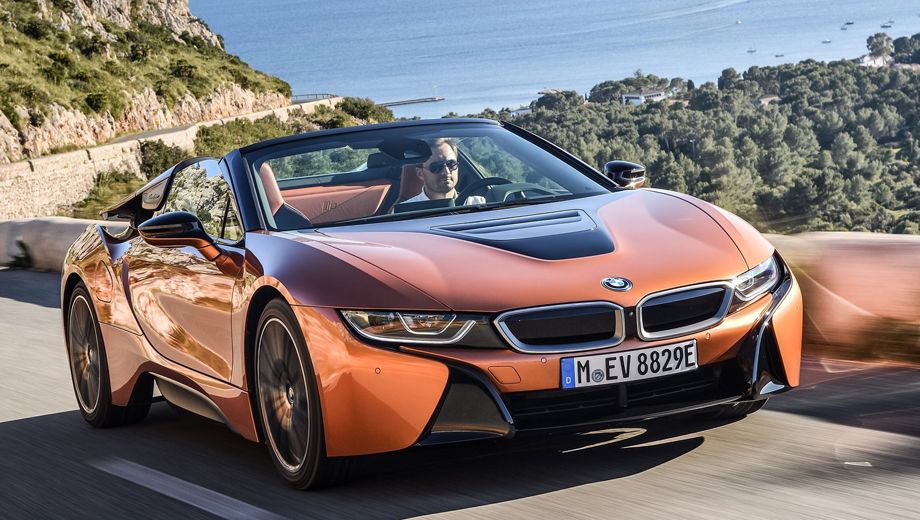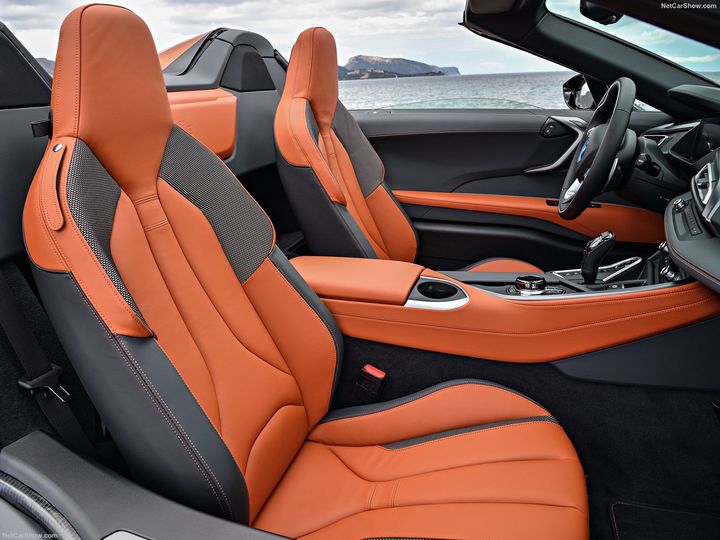BMW's new i8 Roadster is a practical high-end hybrid sports car

The 2019 i8 roadster is the first open-top version of BMW’s excellent i8 hybrid coupe. It's a well-built, thoughtfully designed, fairly priced, and even practical high-end hybrid sports car, with a US$163,000 sticker and gorgeous looks.
Its arched sides are sculpted to reveal air vents swooped across the body of the car like it’s perpetually in motion, while its low stance, squished-to-distinction kidney grille, robot-worthy interior, and propensity for two-tone paint jobs made it an immediate Instagram darling.
This version is even more striking than the i8 coupe, which premiered as a concept in 2009 and is, if you ask me, the best-looking production hybrid car ever made.
On a conference call for last year’s second-quarter earnings report, Chairman Harald Krüger called this first-ever open-air version of BMW's hybrid coupe as “an ace up our sleeve.”
We’ve been waiting for this ace since 2015, when BMW announced its impending arrival.
The i8 is a key part of BMW’s electric plans: By August 2018 electrified vehicles accounted for almost 7 percent of global BMW and Mini sales, compared with a little more than 4 percent in the same month last year.
Overlooked, but it shouldn't be
However, the i8 roadster has been somewhat lost among BMW's recent rash of futuristic electric cars and concepts – despite being far more practical than its science-fiction skin would suggest.
For one thing, it’s not offering much new to the existing coupe model, except for a soft-top that drops in less than 20 seconds and improves the overall look of the car. The most prominent reason it remains relatively unheralded is that its performance isn’t as progressive these days as its spaceship body suggests.
That doesn’t mean you shouldn’t buy it. The BMW i8 roadster is a well-built, thoughtfully designed, fairly priced (among its competition), and even practical high-end hybrid sports car.
But this does merit some inspection. Even with its admittedly few direct competitors, it’s not as fast as other electric and hybrid options.
For instance, its zero to 100km/h sprint time of 4.4 seconds and top speed of 250km/h fall far behind the much sharper-handling Acura NSX hybrid, which records a sprint time of 3.1 seconds and a top speed of 308km/h.
The latest electric vehicles do even better. The Audi e-tron, although still in conceptual stage, is a working car that does the zero-to-100 dash in less than two seconds and has a fully electric range of 500km. The forthcoming plug-in electric Porsche Taycan – even though it’s a larger, heavier sedan – lists a zero to 100 time in 3.5 seconds. In pure-electric mode, the i8 musters a max speed of only 120km/h. Tesla’s Model S has an electric-only top speed of 250km/h.
The brakes on the roadster also left something to be desired in my testing. Rather than having the aggressive bite of carbon and ceramic analog-style brakes, they feel computerized, like stopping in virtual reality instead of the real thing. It’s an abrupt transition between regenerative and friction modes, which helps charge the batteries but does nothing to ensure the smooth stop you’d want from a car that looks so smooth to begin with.
The bright spots
That said, the 2019 i8 roadster does offer some improvement from previous generations of the model line. Its updated lithium-ion battery includes more-efficient cells than in the coupe, packing 11.6 kilowatt-hours of energy into the same space that originally stored only 7.1kWh.
In practical terms, that meant I could drive roughly 30km under electric-only power, which I loved because it was super-stealthily silent navigating Manhattan streets and because it was super-responsive every time I pressed the gas pedal. (Once I switched over to using the conventional engine, there was a slight lag between the time I pushed the accelerator and when the car would lunge forward.)
Better yet, if you drive the i8 roadster in the six-gear “manual” mode, you automatically recharge the battery faster and for longer as you go. A small gauge on the dashboard shows how much energy you gain as you drive; it proved to be a fun game as I drove 90 minutes out on an airport run one evening. I gained back 19km of electric-only driving on the 21km drive there.
Elsewhere, the lightly weighted, electrically assisted power steering remained as direct and precise as you’d expect from a company that claims the title of "Ultimate Driving Machine," even in convertible form. (Physics mean convertibles, with their lopped-off tops, are often stiffer and slower to drive aggressively than their coupe counterparts.)
And let’s not forget that the award-winning engine and hybrid system set the standard for what a hybrid sports car should be when they made their debut. The roadster comes with an updated 141-horsepower electric motor that sources energy from the lithium-ion battery to power the front axle; it switches seamlessly back and forth from the 228-horsepower, three-cylinder combustion engine that drives the rear wheels.
Redeeming values
Other positive notes: The vertically opening doors look cool and are light and easy to lift, though their novel angle and the low ride height of the car mean it takes some expert duck-and-rolling for anyone over 1.8m to get inside.
If you have a beer belly, forget about it - I watched helplessly as valets struggled awkwardly to wedge themselves behind the steering wheel at angles usually reserved for backyard barbecue limbo tournaments.
The interior dash is as clean and crisp as BMW is often wont; the heated, leather-wrapped seats, cloth and carbon-fiber trimming, and driver-focused steering wheel and controls combine comfort and sport as well as anything else today.
While interior noise with the top up is not as low as you might hope, the soft-top roof unfolds quickly and silently at the touch of a button.
The trunk is even large enough to fit two small duffels, or one medium-size hard travel case, and the rear cubby behind the two seats is surprisingly useful in the absence of even a small back seat or rear ledge.
In the meantime
I’m deliberately not calling the i8 roadster a hybrid supercar here, because it’s not. In fact, the i8 roadster is not as progressive an apparatus as what you might find in the Jaguar I-Pace SUV or the Audi e-tron quattro, or even in the latest Tesla models.
But it is fun to drive and shows off well - it’ll get plenty of positive attention in your neighborhood, especially in the handsome dark slate colorway offered with the roadster version.
It’s also extremely drivable on a daily basis, with an AWD and forgiving suspension system that easily handle the potholes, steep inclines, and abrupt curbs.
It’s no accident the i8 is still the best-selling plug-in hybrid sports car on the market today; it premiered in near-perfect form and since then has withstood the test of time. It looks as cool as any supercar but is a whole lot easier to own and more fun to drive. I expect the roadster version to carry on that tradition well.
BMW’s Krüger has said that by 2025 he plans to sell 25 electrified models, 12 of them pure electric. Until we see any other exciting options from BMW hitting the road, the 2019 i8 roadster is more than enough.
In Australia, the BMW i8 Roadster carries a manufacturer's recommended list price of $348,900.
















19 Oct 2018
Total posts 1
US$163,000 sticker => Aus recommended list price of $348,900 .. wow. I have some USD to sell them if this is the rate they're using ..
07 Jan 2011
Total posts 53
Thanks luxury car tax...
Hi Guest, join in the discussion on BMW's new i8 Roadster is a practical high-end hybrid sports car